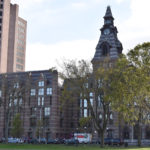Dixwell’s Q-House, beloved community center, reopens after 18 years
On Nov. 6, leaders and partners of Dixwell’s Q-House hosted a ribbon-cutting ceremony for the reopened community center that ended in public tours of the new building.

Brian Zhang, Contributing Photographer
After 18 years and around $16 million of funding, more than 800 beaming children and their parents gathered at 197 Dixwell Ave. on Saturday as community members celebrated the reopening of the Q-House, Dixwell’s beloved community center.
The Dixwell Community Center, or Q-House, held its ribbon-cutting ceremony on Saturday at 11 a.m., celebrating the revival of part of New Haven’s history, present and future. Following a dynamic marching band and cheerleading performance courtesy of Southern Connecticut State University’s Blue Steel Drumline and Hillhouse High School, the event saw a series of speaker presentations from city leaders and the Q-House advisory board, including Ward 22 Alder Jeanette Morrison, former mayor Toni Harp and mayor re-elect Justin Elicker. Together, they commended the support of the many partnering organizations that made the center’s renovation and reopening possible, alongside the resilience and financial contributions of the Dixwell community as it pushed to “keep the House.” Attendees of the ceremony were then divided into small groups as they toured the two-story building.
“The concept is about empowerment of all,” said Morrison, who spearheaded the center’s reconstruction throughout the years. “[The Q-House] is a place to hope and dream and to exercise those things to make them a reality.”
Through its various accommodations, the new Q-House gives residents of all backgrounds the building blocks necessary to “navigate and innovate” these dreams, according to Morrison, who herself enrolled in a weekly gymnastics course at the center as a child. Q-House emphasizes education and recreation alike, Morrison said.
On Saturday, featured facilities include a library, elderly lounge, museum, game rooms, gymnasiums and kitchens. Though the accessibility and focus of specific areas in the Q will cater to certain age groups depending on the time of day, the services are provided for free and locals may reserve a space for themselves, family or friends.
Despite the current building being the center’s third rendition, Morrison explained that its original purpose as a 1920s settlement house has not changed. Both then and now, the center has strived to take care of those with limited access to economic and social opportunities, regardless of race and socioeconomic status. Saturday’s tour left many reminiscing of the various social activities in the Q that they or their children had once participated in.
Elsa Holahan, a junior at Hillhouse High School and a youth director on the center’s advisory board, stated that the Q’s history is based on the “stories and narratives” of community members, particularly those of Black New Haveners. Q’s new internal museum, named after Harp and her husband, captures these struggles and achievements of New Haven’s Black community through a multimedia display of historical photographs, art and documents.
Henry Fernandez, the executive director of Leadership, Education & Athletics in Partnership, a New Haven-based youth mentorship program, explained that the current building’s architecture has not left out its history. It maintains the African and religious motifs characteristic of the first version of the Q in 1924, thanks to the efforts of Fernandez’s friend and fellow New Havener Regina Winters-Toussaint, who designed the building before she passed away in 2016.
“This [building] is a testament to who [Winters] was as an architect,” Fernandez said. “It is a testament to her faith, and it is a testament to her love for children as the people of New Haven.”
Saturday’s ceremony marked the beginning of the Q-House’s revived legacy. New additions, including an operational space for Cornell Scott-Hill Health, will soon be made. Event speakers frequently emphasized Q’s commitment to empowering the city’s children. The newly renovated Stetson Library, for example, caters specifically to the youth. It now features an expanded African-American literature collection from the Diaspora and a teen area with interactive technology. Similarly, young residents played a pivotal role in the preservation of the “giant big family” that is Ward 22 — where “everyone looks out for each other,” said local Valerie McKinnie.
“We now have the opportunity to create our own everlasting memories,” Holahan said. “The Dixwell Q-House that we happily stand before today will unequivocally serve to support … the future generation of New Haven throughout the conquest of time.”
See here for the complete layout of the new Q-House.









